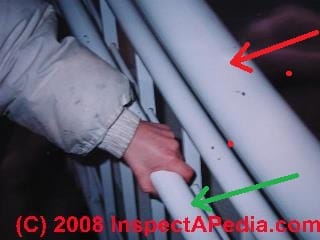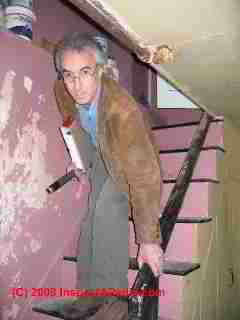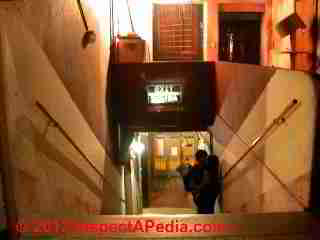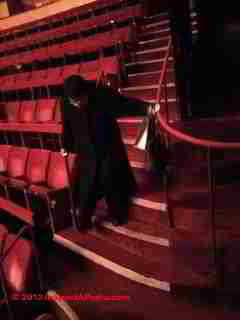 Handrail Graspability Codes
Handrail Graspability Codes
Model building code specifications & standards on Handrailing Graspability
- POST a QUESTION or COMMENT on the graspability or hand-hold capability of building handrails
Handrailing graspability codes:
This article explains and illustrate the requirements for graspable handrails & railings used inside or outside buildings, including guardrails, hand railings on steps and stairs, and stair rails or stair guards for both interior and exterior stairways. used on stairs, balconies, decks, ramps, walks.
This article series explains and illustrate the requirements for graspable handrails & railings used inside or outside buildings, including guardrails, hand railings on steps and stairs, and stair rails or stair guards for both interior and exterior stairways. used on stairs, balconies, decks, ramps, walks.
InspectAPedia tolerates no conflicts of interest. We have no relationship with advertisers, products, or services discussed at this website.
- Daniel Friedman, Publisher/Editor/Author - See WHO ARE WE?
A Comparison of Building Codes Specifying Hand Railing Graspability Requirements
 Here we include descriptions & definitions of graspability for handrailings, and we illustrate safe and unsafe, graspable and not-graspable handrailings in sketches, photographs, and building code citations. These stair and railing articles provide building code specifications, sketches, photographs, and examples of stair & railing safety defects used in inspecting indoor or outdoor stair railings or handrails and related conditions for safety and proper
construction. [Click to enlarge any image]
Here we include descriptions & definitions of graspability for handrailings, and we illustrate safe and unsafe, graspable and not-graspable handrailings in sketches, photographs, and building code citations. These stair and railing articles provide building code specifications, sketches, photographs, and examples of stair & railing safety defects used in inspecting indoor or outdoor stair railings or handrails and related conditions for safety and proper
construction. [Click to enlarge any image]
Summary of Handrailing Space, Location, Height, Continuity Codes
- Handrailing spaced from wall: (=> 1.5" )
- Handrailing projection into stairs (<= 4.5")
- Handrailing height (=> 31.5" one-side-rail, or =>27" with rails on two sides)
In 1984 Maki et als demonstrated the effect of handrailing height on the stability of people using stairs. [41][42][43] - Handrailing height: U.S. handrails for stairs with one side against a wall: 30-38"
- Handrailing height: U.S. handrails at open stairs: 34-38" above the stairs
- Handrailing height: Canadian stair handrails: 32-36" above the stairs
- Handrailing continuity: handrailings should be continuous - that is a hand can slide along the rail without interruption from above the top riser to above the bottom riser; Some local codes may permit that rails can be interrupted at a newel post - but not according to the ICBO as we cite below.
See details at NEWEL POST CONSTRUCTION.
Our photo just below indicates mid-stairway activities that could require secure handrails at a Tango dance hall in Buenos Aires.
International Building Code 2000 (BOCA, ICBO, SBCCI) Handrail Rules
1003.3.3.11.3 Handrail grasp ability.
Handrails with a circular cross section shall have an outside diameter of at least 1.25 inches (32 mm) and not greater than 2 inches (51 mm) or shall provide equivalent grasp ability.
If the handrail is not circular, it shall have a perimeter dimension of at least 4 inches (102 mm) and not greater than 6.25 inches (159 mm) with a maximum cross-section dimension of 2.25 inches (57 mm). Edges shall have a minimum radius of 0.125 inch (3.2 mm).
100333.11.4 Continuity. Handrail-gripping surfaces shall be continuous, without interruption by newel posts or other obstructions.
BOCA National Property Maintenance Code 1993 Handrailing Requirements
PM-305.5 Stairs and railings: all interior stairs and railings shall be maintained in sound condition and good repair.
Commentary: Handrails, treads and risers must be structurally sound, firmly attached to the structure, and properly maintained to perform their intended function safely. During an inspection the code official should inspect all stringers, risers, treads, and handrails.
Uniform Building Code Stairway, Railing, & Guardrail Specifications (UBC 10.3.3.36)
Using 1997 UBC version as a model [38]
Stair Handrail requirements:
Stairways shall have handrails on each side, and every stairway required to be more than 88 inches (2235 mm) in width shall be provided with not less than one intermediate handrail for each 88 inches (2235 mm) or required width. Intermediate handrails shall be spaced approximately equally across with the entire width of the stairway.
Exceptions:
1. Stairways less than 44 inches (1118 mm) in width or stairways serving one individual dwelling unit in Group R, Division 1 or 3 Occupancy or a Group R, Division 3 congregate residence may have one handrail.
2. Private stairways 30 inches (762) or less in height may have a handrail on one side only.
3. Stairways having less than four risers and serving one individual dwelling unit in Group R, Division 1 or 3, or a Group 4, Division 3 congregate residence or Group U Occupancies need not have handrails.
California Building Code Handrailing Specifications (CBC 1003.3.3.6)
The intent of a handrail is to provide a handgrip for people using a stairway. Stairways which serve an individual dwelling unit must have a handrail on one side if they have four risers or more.
Such stairways with fewer than four risers are not required to have handrails. Handrails projecting from a wall shall have not less than 1 1/2 inches between the wall and handrail.
Handrails must be placed between thirty-four and thirty-eight inches above the nosing of the stair treads.
Ends [of the stair handrailings] must be returned or have rounded terminations or bends. The handgrip portion of handrails shall not be less than 1 1/4 inches nor more than 2 inches in cross-sectional dimension or the shape shall provide an equivalent gripping surface.
The handgrip portion of handrails shall have a smooth surface with no sharp corners. [37]
CA & OSHA Codes for [Graspable] Handrails Along Stairs & for Stair Rails Along Open Stairways as Guards

Some building stair codes (CA/OSHA Title 8 Section 1626) leave readers a little confused between the definition of handrail (green arrow) and guardrail, by adding a third term, stair rail (red arrow in our photo).
A stair rail is basically a guard rail along an open stairway. A stair rail may itself be graspable and serve as a handrailing, or the stair rail might be higher, larger, and not-graspable, as shown in our photo at left. [When these stairs were first constructed, the handrail was not present.]
The following requirements apply to all stairways as indicated:
1926.1052(c)(1) Stairways having four or more risers or rising more than 30 inches (76 cm), whichever is less, shall be equipped with:
(A) At least one handrail; and
(B) A stair rail consisting of a top rail and mid-rail along each unprotected side or edge.
This separation of handrail from stair rail appears intended to permit the construction of the equivalent of a "guardrailing" along open stairways and consisting of not just the horizontal members described in (B) above.
But along an open stairway there will also be a requirement for vertical balusters or other means of enclosing the open or unprotected side or edge. Here "unprotected" side or edge means an "open" stairway - that is, stairs that do not run along an enclosing building wall.
California CA/OSHA Title 8 Building Code Stair & Railing Safety & Construction Details
Note: this code establishes minimum occupational safety & health standards that apply to all places of employment in California. This is not a residential building code requirement, but this text in our OPINION models stair construction safety & design specifications. Also
see STAIR TREAD DIMENSIONS and the other stair measurement parameter subtopics outlined in our detailed article links listed at the ARTICLE INDEX the bottom of this article .
CA OSHA Title 8 Section §3214. Stair Rails and Handrails [35]
(a) Stairways shall have handrails or stair railings on each side, and every stairway required to be more than 88 inches in width shall be provided with not less than one intermediate stair railing for each 88 inches of required width. Intermediate stair railings shall be spaced approximately equal within the entire width of the stairway.
Note: Intermediate stair railings may be of single rail construction.
Exceptions:
(1) Stairways less than 44 inches in width may have one handrail or stair railing except that such stairways open on one or both sides shall have stair railings provided on the open side or sides.
(2) Stairways having less than four risers need not have handrails or stair railings.
(3) Stairways giving access to portable work stands less than 30 inches high.
(4) Stairs that follow the contour of tanks or other cylindrical or spherical structures where the construction requires the inside clearance between the inside stair stringer and wall or tank side to be 8 inches or less, shall not be considered an "open side."
(5) Guardrails may be erected provided a handrail is attached.
(b) A stair railing shall be of construction similar to a guardrail (see Section 3209) but the vertical height shall be in compliance with Section 3214(c). Stair railings on open sides that are 30 inches or more above the surface below shall be equipped with midrails approximately one half way between the steps and the top rail.
Note: Local building standards may require 4-inch spacing of intermediate vertical members.
(c) The top of stair railings, handrails and handrail extensions installed on or after April 3, 1997, shall be at a vertical height between 34 and 38 inches above the nosing of treads and landings. For stairs installed before April 3, 1997, this height shall be between 30 and 38 inches.
Stair railings and handrails shall be continuous the full length of the stairs and, except for private stairways, at least one handrail or stair railing shall extend in the direction of the stair run not less than 12 inches beyond the top riser nor less than 12 inches beyond the bottom riser.
Ends shall be returned or shall terminate in newel posts or safety terminals, or otherwise arranged so as not to constitute a projection hazard.
(d) A handrail shall consist of a lengthwise member mounted directly on a wall or partition by means of brackets attached to the lower side of the handrail so as to offer no obstruction to a smooth surface along the top and both sides of the handrail. The handrail shall be designed to provide a grasping surface to avoid the person using it from falling. The spacing of brackets shall not exceed 8 feet.
(e) Handrails projecting from a wall shall have a space of not less than 1 1/2 inches between the wall and the handrail.
(f) The mounting of handrails shall be such that the completed structure is capable of withstanding a load of at least 200 pounds applied in any direction at any point on the rail.
Exception: Handrails and stair rails on flights of stairs serving basements or cellars that are covered by a trap door, removable floor or grating when not in use, shall stop at the floor level or entrance level so as not to interfere with the cover in the closed position. (Title 24, Part 2, Section 1006.9.2.7a.)
Note: Authority cited: Section 142.3, Labor Code. Reference: Section 142.3, Labor Code; and Section 18943(b), Health and Safety Code.
OSHA Handrail Code Summary
Handrailing Graspability Details: OSHA's requirements
Our photo illustrates a handrail that is indeed "graspable" in New York's Carnagie Hall.
OSHA requires:
- Handrail Graspability: Handrails must provide an adequate handhold for employees to grasp to prevent falls.
- Handrail Strength: Handrails and top rails of the stair rail systems must be able to withstand, without failure, least 200 pounds (890 n) of weight applied within 2 inches (5 cm) of the top edge in any downward or outward direction, at any point along the top edge.
- Handrail Height: Handrails must not be more than 37 inches (94 cm) high nor less than 30 inches (76 cm) from the upper surface of the handrail to the surface of the tread.
- Temporary handrails must have a minimum clearance of 3 inches (8 cm) between the handrail and walls, stair rail systems and other objects.
- Handrail vs Stairway height: Stairways with four or more risers, or that rise more than 30 inches (76 cm) in height- whichever is less- must have at least one handrail.
- Winding or spiral stairways must have a handrail to prevent use of areas where the tread width is less than 6 inches (15 cm).
Also see HANDRAIL CODES & OSHA HAND RAIL SPECS
Full Text of Adopted Building Codes 2006, 2012
- ALASKA, ARKANSAS, & Other U.S. STATES 1 & 2 FAMILY BUILDING CODE 2006 [PDF] Alaska, Arkansas, Colorado, District of Columbia, Georgia, Kentucky, Minnesota, Montana, Nevada, New HYork, South Carolina, Wyoming, et alia as they adopted their version of the International Residential Code® For One- and Two- Family Dwellings, 2006, Retrieved 2016/09/17 original source: online ref for ICC_IRC (2006) https://law.resource.org/pub/us/code/ibr/icc.irc.2006.pdf (appendix E)
- MARYLAND & TEXAS RESIDENTIAL CODE (2012) based on the state or municipality's adoption of ICC or IRC model building codes for that year, [PDF] [17 MB] Retrieved 2016/09/17 original source: online ref for IRC 2012 version https://learnframing.com/wp-content/uploads/2014/08/IRC.pdf (the 2012 version)
The ICC has free, limited, live, online access to some of the latest codes, but I couldn't find the free link for IRC immediately.
- Also see Subtitle B - REGULATIONS Relating to Housing and Urban Development (Continued) [PDF] - original source www.gpo.gov/fdsys/pkg/CFR-2001-title24-vol5/pdf/CFR-2001-title24-vol5-subtitleB.pdf
Hand Railing Graspability Codes in Other Countries
British, Northern Ireland, & U.K. Stair Building Recommendations
- Northern Ireland STAIR CONSTRUCTION SUGGESTIONS Booklet [PDF] Building Control NI, Building Control Northern Ireland, retrieved 2017/01/07, original source: http://www.buildingcontrol-ni.com/assets/pdf/H2006.pdf providing contact information for these councils: Antrim and Newtownabbey Borough Council Ards and North Down Borough Council, Armagh City Banbridge & Craigavon Borough Council, Belfast City Council, Causeway Coast & Glens Borough Council, Derry City & Strabane District Council, Fermanagh and Omagh City Council, Lisburn & Castlereagh City Council, Mid & East Antrim Borough Council, Mid Ulster District Council, and Newry, Mourne and Down District Council
Finnish Stair & Building & Accessiblity Decrees & Regulatoins
 Reader opinion: Showcase stairs compared with Safe stairs
Reader opinion: Showcase stairs compared with Safe stairs
We recently stayed at [a] 4 star Hotel in Tampere Finland where my wife suffered multiple fractures due to a fall down a marble staircase, the result of a missing graspable handrail, among other things.
The subject staircase was over 1000mm wide and therefore required a second hand rail on the outer perimeter. The Hotel tried to suggest only one hand rail was required, but when I pointed out the building code violation the dialogue ended abruptly with no further comments, except guilty silence from the Hotel and no further responses to my emails.
The marble staircase is actually a showcase as opposed to a safe staircase. It is a curved staircase with varying depth treads, lacking slip resistant friction tapes/strips to provide traction on worn slippery stairs and to delineate the edge of the treads by providing a contrasting visual cue.
Descending the curved stairs can be tricky in that a change-up of stride is required to negotiate the varying tread depths, and thus missteps occur resulting in falls.
For this reason, and according to code requirements, the second handrail is of the utmost importance to steady oneself when descending the stairs and to grasp in an emergency, should one start to fall as in my wife's case.
The top guardrail is probably intended to also serve as the second handrail but the diameter is much too large, over 50mm, and therefore ungraspable to qualify as a handrail according to EU standards or North American standards.
I am attaching photos taken subsequent to the incident and also a publicity photo of the Hotel manager posing on the staircase, to illustrate how inadequate the top guard rail appears as a graspable handrail.

I am hoping that perhaps some of these photos can be used on your website as a warning, that a staircase, although beautiful and elegant, is not necessarily functionally safe, but rather presents a cruel deceptive danger to public safety.
Please continue with your informative work for the public good..... - Kal Haikola [by private email]
to editor, 2017/01/07
Reply:


We are certainly sorry that your wife suffered stair fall injuries. OPINION: Such falls are particularly painful and acute since by nature one is falling down more than one would on a level surface and across the edges of stair treads as well.
By your photos the handrail looks considerably too-large in diameter to be graspable, thus increasing the risk of fall injuries by denying a stairway user the opportunity to grasp the railing to arrest a fall. It may also be at the wrong height. More un-graspable handrails are illustrated
at HANDRAIL GRASPABILITY DEFECT PHOTOS.
I also agree that polished marble walking surfaces, including stairs, can be particularly slippery, and considerably more slippery if the surfaces (or soles of shoes) are wet or soiled. Smooth-soled leather and some other shoe surfaces also add to the slipperiness hazard.
I also agree that because they require variation in the tread shape and pattern, curved and angled stairs can pose additional stair-fall hazards.
See CIRCULAR & CURVED STAIRS and
also WINDER or ANGLED STAIRS.
The requirement for an intermediate or central handrailing in wide stairways is in my experience very inconsistently enforced if it is stated at all. Even in New York City where there are acute building regulations and inspections I find some wide stairways with no intermediate railing, such as at the recently-renovated Metropolitan of Modern Art building in Manhattan.
Finnish stair regulations, excerpting from the country's Barrier-free Building Regulations (2005) attached, includes this assertion:
Easy-to-use and secure handrails must be fitted on both sides of ramps and stairs in foyers, in any other internal traffic areas and in outside locations. The handrails must also continue uninterrupted on half landings.
The exact dimensions and heights for handrails and guardrails are not given in the documents I could find.
I see an additional, smaller-diameter (and possibly graspable) handrailing along the wall in your photos. I have observed that a right-handed person usually prefers to ascend where she can grasp the handrail on the right and descend where she'd grasp one on her left. However a stair designer must assume that users of the stairs may for a variety of reasons have to walk anywhere in the width of the stairway.
I include some of your photos though they're small and blurry. I'll see if my software can improve the sharpness of your images.
See also these building codes and decrees for Finland:
- FINNISH ACCESSIBLE BUILDING DECREE 2004-2005 [PDF], Barrier-free Building Regulations and Guidelines 2005, Ministry of the Environment Decree on accessible building, retrieved 2017/01/07
- FINNISH BUILDING DESIGNERS & PLANS DECREE 2002 [PDF], Building designers and plans A2 Regulations and guidelines 2002, Ministry of the Environment Decree, on building designers and plans, retrieved 2017/01/07
- FINLAND HOUSING DESIGN DECREE, 2004, [PDF] G1 THE NATIONAL BUILDING CODE OF FINLAND Housing Design Regulations and Guidelines 2005, Ministry of the Environment Decree on housing design, retrieved 2017/01/07
- FINLAND FIRE SAFETY CODES & DECREE 2002 [PDF], E1 THE NATIONAL BUILDING CODE OF FINLAND, Fire safety of buildings, Regulations and guidelines 2002, Decree of the Ministry of the Environment on fire safety of buildings, retrieved 2017/01/07
Comment: U.S. NFPA 101 Code on handrail height, diameter, graspability
(July 26, 2016) NHFireBear said:
The NFPA 101 Life Safety Code requirements for handrail height, diameter and graspability are found in section 7.2.2.4.
Generally:
- 30 to 38 inches above the stair tread (but at least 34, if new), both sides of the stairway (unless exempt),
- 1-1/4 to 2-inch diameter round profile or
- up to 2-1/4 inches if other than round profile, but
- on a railing having no more than a 6-1/4-inch perimeter.
- Handrails forming part of a guard may be as high as 42 inches above the front edge of the stair treads.
Reply:
Thank you NHFB for this stair handrail code update. Readers: the commenter is an attorney and a building inspector and a frequent contributor to InspectApedia.com. Other techincal reviewers are listed at ABOUT InspectApedia.com.
Handrail Graspability Code & Safety Research
- [1] YALE UNIVERSITY GUIDELINES FOR UNDERGRADUATE THEATRICAL PRODUCTIONS AND SPECIAL EVENTS [PDF] Yale University’s Office of Undergraduate Productions, Office of the Fire Marshal, and Office of Environmental Health & Safety April 2005, web search 8/9/11, original source: http://www.yale.edu/oup/forms/pdf/guidelines.pdf
- [2] CUE40303 CERTIFICATE IV IN LIVE PRODUCTION, THEATRE AND EVENTS (TECHNICAL OPERATIONS) [PDF], Australian Government, Department of Education, Employment, and Workplace Relations, web search 8/9/11, original source: https://www.training.nsw.gov.au/cib_vto/cibs/documents/cue40303.pdf
- [3] ELECTRICAL SAFETY IN THE THEATRE [PDF], Broadway Press, web search 8/9/11, original source: http://www.broadwaypress.com/PDFs/LTSpdfs/LTSchpt13.pdf - quoting:
Referring to the NEC will provide the technician with details specifically related to the theatre and moreover, these regulations will
be better suited to the needs of the theatre. - [4] Illustrated theatre production guide, John Holloway, Focal Press, 2002, ISBN 0240804937, 9780240804934
- [5] HOW TO BUILD THEATER STAIRS, AN ILLUSTRATED GUIDE [PDF], Ben Teague, www.benteague.com, Amateur Theatre Division, December 2004, web search 8/9/11, original source: http://www.benteague.com/features/Stairs.pdf
Note that Mr. Teague warns that his designs and advice do not comply with building codes. - [6] OSHA Publication 3124 - Stairways and Ladder, web search 12/21/11, OSHA Publications Office U.S. Department of Labor 200 Constitution Avenue, NW, N-3101 Washington, DC 20210 Telephone (202) 693-1888 or fax to (202) 693-2498. Original source: osha.gov/Publications/ladders/osha3124.html
- [7] Stephenson, Elliott O., THE ELIMINATION OF UNSAFE GUARDRAILS, A PROGRESS REPORT [PDF] Building Standards, March-April 1993
- [8] "Are Functional Handrails Within Our Grasp" Jake Pauls, Building Standards, January-February 1991
- [11] The Stairway Manufacturers' Association, (877) 500-5759, provides a pictorial guide to the stair and railing portion of the International Residential Code. [copy on file as http://www.stairways.org/pdf/2006%20Stair%20IRC%20SCREEN.pdf ] -
[11a] "Visual Interpretation Of The International Residential Code (IRC) 2006 Stair Building Code", The Stairway Manufacturers Association, [Portions of this document reproduce sections from the 2006 International Residential Code, International Code Council, Falls Church, Virginia.},
The Stairway Manufacturers Association website stairways.org provides free downloads of stairway handrailing profiles and dimensions - [12] Slips, Trips, Missteps and Their Consequences, Gary M. Bakken, H. Harvey Cohen, Jon R. Abele, Alvin S. Hyde, Cindy A. LaRue, Lawyers and Judges Publishing; ISBN-10: 1933264012 ISBN-13: 978-1933264011
- [13] Steps and Stairways, Cleo Baldon & Ib Melchior, Rizzoli, 1989.
- [14] The Staircase, Ann Rinaldi
- [15] Common Sense Stairbuilding and Handrailing, Fred T. Hodgson
- [16] Falls and Related Injuries: Slips, Trips, Missteps, and Their Consequences, Lawyers & Judges Publishing, (June 2002), ISBN-10: 0913875430 ISBN-13: 978-0913875438
"Falls in the home and public places are the second leading cause of unintentional injury deaths in the United States, but are overlooked in most literature. This book is unique in that it is entirely devoted to falls.
Of use to primary care physicians, nurses, insurance adjusters, architects, writers of building codes, attorneys, or anyone who cares for the elderly, this book will tell you how, why, and when people will likely fall, what most likely will be injured, and how such injuries come about. " - [17] Slips, Trips, Missteps and Their Consequences, Gary M. Bakken, H. Harvey Cohen, Jon R. Abele, Alvin S. Hyde, Cindy A. LaRue, Lawyers and Judges Publishing; ISBN-10: 1933264012 ISBN-13: 978-1933264011
- [18] Slips, Trips, Missteps and Their Consequences, Second Edition, Gary M. Bakken, H. Harvey Cohen,A. S. Hyde, Jon R. Abele, ISBN-13: 978-1-933264-01-1 or ISBN 10: 1-933264-01-2, available from the publisher, Lawyers ^ Judges Publishing Company,Inc., www.lawyersandjudges.com sales@lawyersandjudges.com
- [19] Arts, Crafts, & Theater Safety (ACTS), 181 Thompson Street, #23
New York, NY 10012-2586
Telephone: (212) 777-0062
E-Mail: ACTSNYC@cs.com, web search 5/9/12, website: http://www.artscraftstheatersafety.org/ - Quoting:
ACTS is a not-for-profit corporation that provides health, safety, industrial hygiene, technical services, and safety publications to the arts, crafts, museums, and theater communities. A part of the fees from our consulting services goes to support our free and low-cost services for artists.
- [20] Access Ramp building codes:
- UBC 1003.3.4.3
- BOCA 1016.3
- ADA 4.8.2
- IBC 1010.2
- [21] Access Ramp Standards:
- ADA (Americans with Disabilities Act), Public Law 101-336. 7/26/90 is very often cited by other sources for good design of stairs and ramps etc. even where disabled individuals are not the design target.
- ANSI A117.4 Accessible and Usable buildings and Facilities (earlier version was incorporated into the ADA)
- ASTM F 1637, Standard Practice for Safe Walking Surfaces, (Similar to the above standard
- [22] The Circular Staircase, Mary Roberts Rinehart
- [23] Construction Drawings and Details, Rosemary Kilmer
- [24]"The Dimensions of Stairs", J. M. Fitch et al., Scientific American, October 1974.
- [26] The Art of Staircases, Pilar Chueca
- [27 Building Stairs, by pros for pros, Andy Engel
- [28] A Simplified Guide to Custom Stairbuilding, George R. Christina
- [29] Basic Stairbuilding, Scott Schuttner
- [30] The Staircase (two volumes), John Templar, Cambridge: the MIT Press, 1992
- [31] The Staircase: History and Theories, John Templar, MIT Press 1995
- [32] Steps and Stairways, Cleo Baldon & Ib Melchior, Rizzoli, 1989.
- [33] BUILDING, FIRE, RESIDENTIAL CODES - The 2007 & 2010 California Building Code (Part 2), California Residential Code (Part 2.5) and the California Fire Code (Part 9) of Title 24 are available for viewing online via the following International Code Council web site link: California Codes, Title 24, Part 1, 6, 8, 10, 11 & 12 are also available for viewing and download in PDF form on the
California website: publicecodes.cyberregs.com/st/ca/st/index.htm 2007 Edition of the California Building Codes or see
2010 Edition (Effective Jan. 1, 2011) of the California building codes. Web: publicecodes.cyberregs.com/st/ca/st/index.htm
For a summary page accessing all of the California building codes see http://www.bsc.ca.gov/pubs/codeson.aspx - [34] "Guard Rail Height", CREIA, California Real Estate Inspection Association, Website: http://ask.creia.org, web search 8/1/12 original source: http://ask.creia.org/index.php?topic=424.0, December 2009
- [35] California Department of Industrial Relations - CA/OSHA: California Stair & Railing Code details: Subchapter 7. General Industry Safety Orders, Group 1. General Physical Conditions and Structures Orders, Article 2. Standard Specifications, Section 3214. Stair Rails and Handrails, web search 8/1/12, original source: http://www.dir.ca.gov/title8/3214.html
- [36] California Department of Industrial Relations - CA/OSHA: California Stair & Railing Code details: Subchapter 4. General Industry Safety Orders, Article 17. Ramps, Runways, Stairwells, and Stairs, Section 1626. Stairwells and Stairs., web search 8/1/12, original source: http://www.dir.ca.gov/title8/1626.html
- [37] California Building Code, Nonstructural Design Requirements, web search 08/01/12 original source: http://sanbruno.ca.gov/comdev_images/California_Building_Code.pdf
- [38] Uniform Building Code Stair Specifications: UBC 1003.3.3.6 1997 or later specify handrail requirements, railing heights, rail widths, baluster spacing, stairway types, and guardrail specifications.
- [39] Teruo Uetake & Masahiro Shimnoda, Experimental Study on the Grip and Hold Strength for Staunchions and Handrails in Buses", J. Human Ergol., 35: 11-19, 2006
- [40] A. H. Larsen,
H. Sørensen,
L. Puggaard,
P. Aagaard, "Biomechanical determinants of maximal stair climbing capacity in healthy elderly women", Scandinavian Journal of Medicine & Science in Sports
Volume 19, Issue 5, pages 678–686, October 2009.
Abstract:
Stair walking is an important functional movement task that may require considerable amounts of muscle strength/power. This study aimed to perform a descriptive biomechanical analysis of maximal stair ascent in elderly women and to examine the relationship between mechanical muscle function and maximal stair ascending velocity (MAV).
Seventeen healthy elderly women (age 72.4 ± 6.4) were tested for MAV, maximal multi-joint counter movement jumping (CMJ), and maximal single-joint isokinetic/isometric muscle moment.
Peak knee joint power during MAV was the single independent parameter that explained most of the variation in MAV (50%), however, combining knee and ankle parameters in a multiple regression analysis mean joint power explained 82.4% of the variation in MAV.
Generally, multi-joint CMJ parameters showed stronger correlations with MAV than single-joint isokinetic/isometric muscle strength parameters.
MAV appeared to be highly dependent upon knee and ankle power and to a lesser extent on joint moment and range of motion.
Furthermore, CMJ assessment seemed well applicable in healthy elderly individuals to distinguish between differentiated levels of maximal stair walking capacity. - [41] Brian E. Maki, Sheryl A. Bartlett, Geoff R. Fernie, "Influence of Stairway Handrail Height on the Ability to Generate Stabilizing Forces and Moments", Human Factors: The Journal of the Human Factors and Ergonomics Society December 1984 vol. 26 no. 6 705-714, Authors are at West Park Research, University of Toronto, Toronto, Canada.
Abstract:
An experimental study was performed investigating the influence of handrail height on the ability of stairway users to generate stabilizing forces and moments, with the aim of improving stairway safety by developing better handrail design standards.
The experiments involved measurement of the maximum forces and moments that subjects were able to exert on a handrail while they stood stationary in an upright position. Two age groups were tested: young (20 to 45 years) and elderly (59 years and over), with a total of 35 subjects.
All subjects showed a strong linear dependence on handrail height in generating stabilizing forces and moments. Ability to generate forward/backward forces and forward/backward moments increased linearly with increasing handrail height.
Ability to generate upward force decreased linearly with increasing handrail height. Based on the results, an optimal design range for handrail height was estimated. - [42] A Field Study of Stair Descent Ergonomics in Design: The Quarterly of Human Factors Applications April 1, 2000 8: 11-15 Ergonomics in Design: The Quarterly of Human Factors Applications April 2000 vol. 8 no. 2 11-15
- [43] Brian E. Maki, Sheryl A. Bartlett, Geoff R. Fernie, "Research Note Effect of Stairway Pitch on Optimal Handrail Height:, Human Factors: The Journal of the Human Factors and Ergonomics Society June 1, 1985 27: 355-359
...
Continue reading at GRASPABILITY of HANDRAILINGS or select a topic from the closely-related articles below, or see the complete ARTICLE INDEX.
Or see these
Recommended Articles
- HANDRAILS & HANDRAILINGS - home
- FALL HAZARDS DUE TO UN-GRASPABLE HANDRAILS
- GRASPABILITY of HANDRAILINGS
- HANDRAIL CODES & OSHA HAND RAIL SPECS
- HANDRAIL CODES - GRASPABILITY
- HANDRAIL CONTINUITY
- HANDRAIL EXTENSION REQUIREMENTS
- HANDRAIL GRASPABILITY DEFECT PHOTOS
- HANDRAILING STRENGTH
- HANDRAILS for WIDE STAIRWAYS
- SNAG HAZARDS on STAIRWAYS
- RAILING CODES & STANDARDS - home
- STAIR CODES & STANDARDS - home
- STAIR CODE DETAILS
Suggested citation for this web page
HANDRAIL CODES - GRASPABILITY at InspectApedia.com - online encyclopedia of building & environmental inspection, testing, diagnosis, repair, & problem prevention advice.
Or see this
INDEX to RELATED ARTICLES: ARTICLE INDEX to STAIRS RAILINGS LANDINGS RAMPS
Or use the SEARCH BOX found below to Ask a Question or Search InspectApedia
Ask a Question or Search InspectApedia
Try the search box just below, or if you prefer, post a question or comment in the Comments box below and we will respond promptly.
Search the InspectApedia website
Note: appearance of your Comment below may be delayed: if your comment contains an image, photograph, web link, or text that looks to the software as if it might be a web link, your posting will appear after it has been approved by a moderator. Apologies for the delay.
Only one image can be added per comment but you can post as many comments, and therefore images, as you like.
You will not receive a notification when a response to your question has been posted.
Please bookmark this page to make it easy for you to check back for our response.
IF above you see "Comment Form is loading comments..." then COMMENT BOX - countable.ca / bawkbox.com IS NOT WORKING.
In any case you are welcome to send an email directly to us at InspectApedia.com at editor@inspectApedia.com
We'll reply to you directly. Please help us help you by noting, in your email, the URL of the InspectApedia page where you wanted to comment.
Citations & References
In addition to any citations in the article above, a full list is available on request.
- In addition to citations & references found in this article, see the research citations given at the end of the related articles found at our suggested
CONTINUE READING or RECOMMENDED ARTICLES.
- Carson, Dunlop & Associates Ltd., 120 Carlton Street Suite 407, Toronto ON M5A 4K2. Tel: (416) 964-9415 1-800-268-7070 Email: info@carsondunlop.com. Alan Carson is a past president of ASHI, the American Society of Home Inspectors.
Thanks to Alan Carson and Bob Dunlop, for permission for InspectAPedia to use text excerpts from The HOME REFERENCE BOOK - the Encyclopedia of Homes and to use illustrations from The ILLUSTRATED HOME .
Carson Dunlop Associates provides extensive home inspection education and report writing material. In gratitude we provide links to tsome Carson Dunlop Associates products and services.



